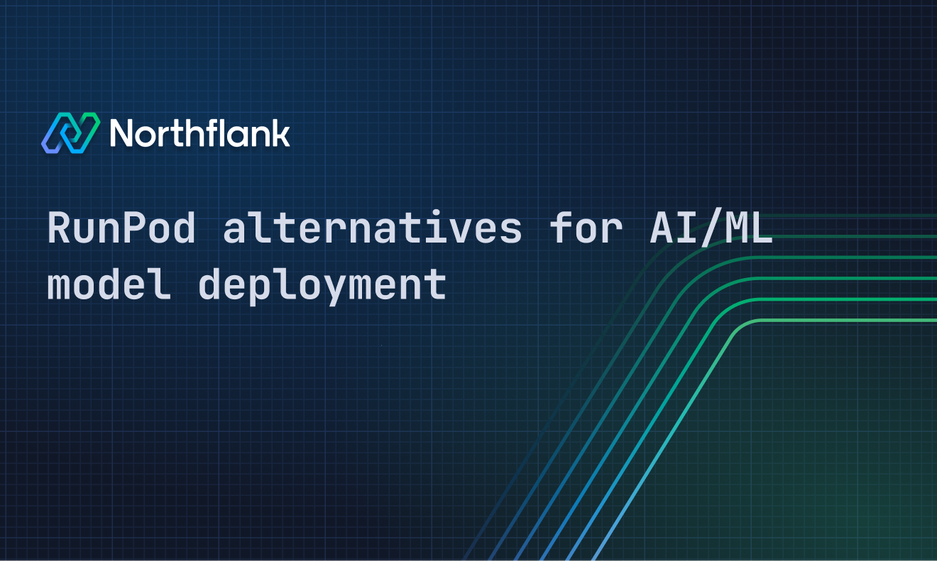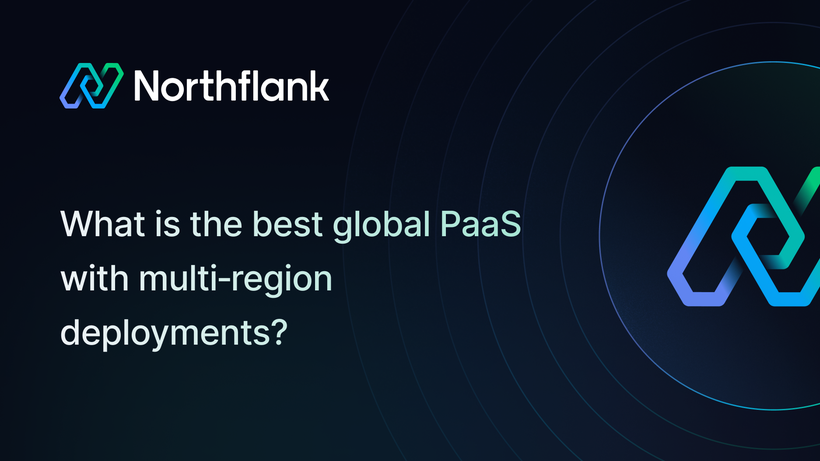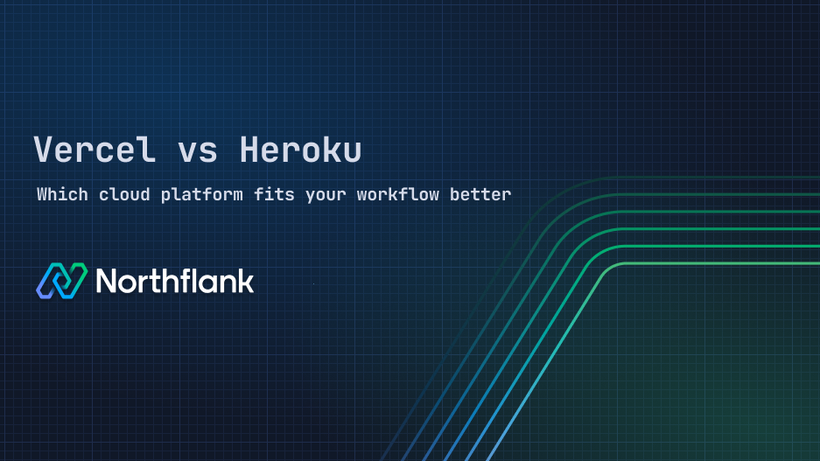

RunPod alternatives for AI/ML deployment beyond just a container
RunPod offers a compelling proposition: take your model, drop it into a Docker container, and instantly get a GPU-backed API. No infrastructure to manage or cloud headaches. Just raw speed.
And to be fair, that’s exactly what it delivers.
If you’re building in a notebook, testing a new checkpoint, or trying to build a demo for investors quickly, RunPod is a dream. You can get an A100-powered endpoint running in under ten minutes. No AWS, Terraform, or ops team.
But once your demo turns into a production-ready product, the magic starts to fade. You hit the scaling walls. You end up hacking around missing infrastructure, things a production platform would handle natively.
This article breaks down why RunPod falls short once you scale, and walks through the best alternatives depending on what you’re actually building, whether that’s a full-stack AI product, an LLM microservice, a RAG agent, or a managed model API.
If you're short on time, here’s a snapshot of the top RunPod alternatives. Each tool has its strengths, but they solve different problems, and some are better suited for real-world production than others.
| Platform | Best For | Why It Stands Out |
|---|---|---|
| Northflank | LLMs, APIs, GPUs, full-stack AI infra | GPU containers, Git-based CI/CD, AI workload support, BYOC, secure runtime, and enterprise-ready features |
| Replicate | Sharing public ML models easily | Ideal for demos and generative models, with public API hosting |
| Modal | Python-first, async jobs, fast iteration | Serverless feel, good for batch workflows |
| Vertex AI | GCP-native ML workflows | Great for GCP orgs, less flexible |
| SageMaker | Enterprise ML pipelines | Deep AWS integration, but heavyweight |
| Hugging Face | Simple LLM APIs from HF-hosted models | Fast setup for popular Hugging Face models, but limited customization |
The genius of RunPod is that it skips everything: infra provisioning, CI/CD, scaling logic, cloud permissions, container registries, load balancers.
All you need is a Docker image and a wallet.
This makes it ideal for:
- Solo builders shipping MVPs
- Tinkering with open-source checkpoints
- GPU benchmarking and quick-turnaround jobs
- Short-term deployments for demos or internal teams
For this use case, it’s nearly perfect. It’s cheaper than Modal, boots faster than SageMaker, and requires zero vendor-specific SDKs.
But if you’re building something production-ready, a customer-facing app, or an inference API that actually needs to stay up and scale under load, RunPod becomes a liability.
At its core, RunPod is a way to rent a container on a GPU, and not much else.
It doesn't manage your deployment lifecycle. It doesn’t help you build safe deploy pipelines, expose metrics, store logs, track uptime, handle auto-scaling, or isolate dev vs. prod.
You bring your container. You run it. That’s it.
What feels like "simplicity" at first turns out to be just absence. There's no platform here. Just compute.
Once you try to scale, RunPod’s limitations become blockers.
RunPod doesn’t connect to GitHub, GitLab, or any CI/CD provider. There’s no native pipeline, rollback, or tagging. You’re managing builds manually, pushing containers by hand, restarting pods, and hoping nothing breaks.
Platforms like Northflank connect directly to your Git repos and CI pipelines. Every commit can trigger a build, preview, or deploy automatically. No custom scripts required.
Everything you launch goes straight to production. There’s no staging, preview branches, or room for safe iteration.
This kills experimentation. There’s nowhere to test model variations or feature branches without risking live traffic.
Platforms like Northflank provide full environment separation by default, with staging, previews, and production all isolated and reproducible.
If your model gets slow or crashes, you’re flying blind. No Prometheus, request tracing, or logs unless you manually SSH and tail them.
There’s no monitoring stack. You can't answer basic questions like: How many requests are failing? How many tokens per second? GPU utilization?
With platforms like Northflank, observability is built in. Logs, metrics, traces, everything is streamed, queryable, and tied to the service lifecycle.
You can’t scale pods based on demand. There’s no job queue. No scheduled retries. Every container is static. That means overprovisioning and paying for idle GPU time, or building your own orchestration logic.
By default, Northflank supports autoscaling, scheduled jobs, and queue-backed workers, making elastic GPU usage feel native.
RunPod can run one thing: a container. If you need a frontend, a backend API, a queue, a DB, a cache? You’re cobbling together services across platforms. That fragmentation adds latency, complexity, and risk.
Northflank treats multi-service apps as first-class citizens. You can deploy backends, frontends, databases, and cron jobs—fully integrated, securely networked, and observable in one place.
RunPod is built for trusted team environments, but it doesn’t offer secure runtime isolation for executing untrusted or third-party code. There’s no built-in sandboxing, syscall filtering, or container-level hardening. If you're running workloads from different tenants or just want extra guarantees around runtime isolation, you’ll need to engineer those protections yourself.
By contrast, Northflank containers run in secure, hardened sandboxes with configurable network and resource isolation, making it easier to host untrusted or multitenant workloads out of the box safely.
RunPod runs on its own infrastructure. There’s no option to deploy into your own AWS, GCP, or Azure account. That means: no VPC peering, private networking, or compliance guarantees tied to your organization's cloud, and no control over regions, availability zones, or IAM policies. If your organization needs to keep workloads within a specific cloud boundary for compliance, cost optimization, or integration reasons, RunPod becomes a non-starter.
By contrast, platforms like Northflank support BYOC, letting you deploy services into your own cloud infrastructure while still using their managed control plane.
RunPod works if all you need is a GPU and a container.
But production-ready AI products aren’t just containers. They’re distributed systems. They span APIs, workers, queues, databases, model versions, staging environments, and more. That’s where RunPod starts to fall short.
As soon as you outgrow the demo phase, you’ll need infrastructure that supports:
- CI/CD with Git integration – Ship changes confidently, not by SSH.
- Rollbacks and blue-green deploys – Avoid downtime, roll back instantly.
- Health checks and probes – Know when something’s broken before your users do.
- Versioned APIs and rate limiting – Manage usage and backward compatibility.
- Secrets and config management – Keep credentials out of code.
- Staging, preview, and production environments – Test safely before shipping.
- Scheduled jobs and async queues – Move beyond synchronous APIs.
- Observability: logs, metrics, traces – Understand and debug your system.
- Multi-region failover – Stay online even when a zone isn’t.
- Secure runtimes – Safely run third-party or multitenant code.
- Bring Your Own Cloud (BYOC) – Deploy where you control compliance and cost.
You’re not just renting a GPU.
You’re building a platform that's resilient, observable, and secure. You need infrastructure that thinks like that too.
Here is a list of the best Runpod alternatives you can find. In this section, we talk about each platform in depth, its top features, pros, and cons.
Northflank isn’t just a model hosting tool; it’s a production-grade platform for deploying and scaling production-ready AI products. It combines the flexibility of containerized infrastructure with GPU orchestration, Git-based CI/CD, and full-stack app support.
Whether you're serving a fine-tuned LLM, hosting a Jupyter notebook, or deploying a full product with both frontend and backend, Northflank gives you everything you need, with none of the platform lock-in.

Key features:
- Bring your own Docker image and full runtime control
- GPU-enabled services with autoscaling and lifecycle management
- Multi-cloud and Bring Your Own Cloud (BYOC) support
- Git-based CI/CD, preview environments, and full-stack deployment
- Secure runtime for untrusted AI workloads
- SOC 2 readiness and enterprise security (RBAC, SAML, audit logs)
Pros:
- No platform lock-in – full container control with BYOC or managed infrastructure
- Transparent, predictable pricing – usage-based and easy to forecast at scale
- Great developer experience – Git-based deployments, CI/CD, preview environments
- Optimized for latency-sensitive workloads – fast startup, GPU autoscaling, low-latency networking
- Supports AI-specific workloads – Ray, LLMs, Jupyter, fine-tuning, inference APIs
- Built-in cost management – real-time usage tracking, budget caps, and optimization tools
Cons:
- No special infrastructure tuning for model performance.
Verdict:
If you're building production-ready AI products, not just prototypes, Northflank gives you the flexibility to run anything from Ray clusters to full-stack AI apps in one place. With built-in CI/CD, GPU orchestration, and secure multi-cloud support, it's the only platform designed for teams who need speed and control without getting locked in.
Replicate is purpose-built for public APIs and demos, especially for generative models. You can host and monetize models in just a few clicks.

Key features:
- Model sharing and monetization
- REST API for every model
- Popular with LLMs, diffusion, and vision models
- Built-in versioning
Pros:
- Zero setup for public model serving
- Easy to showcase or monetize models
- Community visibility
Cons:
- No private infra or BYOC
- No CI/CD or deployment pipelines
- Not built for production-ready apps or internal tooling
Verdict:
Great for showcasing generative models, not for teams deploying private, production workloads.
Modal makes Python deployment effortless. Just write Python code, and it handles scaling, packaging, and serving — perfect for workflows and batch jobs.

Key features:
- Python-native infrastructure
- Serverless GPU and CPU runtimes
- Auto-scaling and scale-to-zero
- Built-in task orchestration
Pros:
- Super simple for Python developers
- Ideal for workflows and jobs
- Fast to iterate and deploy
Cons:
- Limited runtime customization
- Not designed for full-stack apps or frontend support
- Pricing grows with always-on usage
Verdict:
A great choice for async Python tasks and lightweight inference. Less suited for full production systems.
Vertex AI is Google Cloud’s managed ML platform for training, tuning, and deploying models at scale.

Key features:
- AutoML and custom model support
- Built-in pipelines and notebooks
- Tight GCP integration (BigQuery, GCS, etc.)
Pros:
- Easy to scale with managed services
- Enterprise security and IAM
- Great for GCP-based teams
Cons:
- Locked into the GCP ecosystem
- Pricing can be unpredictable
- Less flexible for hybrid/cloud-native setups
Verdict:
Best for GCP users who want a full-featured ML platform without managing infra.
SageMaker is Amazon’s heavyweight MLOps platform, covering everything from training to deployment, pipelines, and monitoring.

Key features:
- End-to-end ML lifecycle
- AutoML, tuning, and pipelines
- Deep AWS integration (IAM, VPC, etc.)
- Managed endpoints and batch jobs
Pros:
- Enterprise-grade compliance
- Mature ecosystem
- Powerful if you’re already on AWS
Cons:
- Complex to set up and manage
- Pricing can spiral
- Heavy DevOps lift
Verdict:
Ideal for large orgs with AWS infra and compliance needs. Overkill for smaller teams or solo devs.
Hugging Face is the industry’s leading hub for open-source machine learning models, especially in NLP. It offers tools for accessing, training, and lightly deploying transformer-based models.

Key Features:
- Model Hub with 500k+ open-source models
- Inference Endpoints (managed or self-hosted)
- AutoTrain for low-code fine-tuning
- Spaces for demos using Gradio or Streamlit
- Popular
transformerPython library
Pros:
- Best open-source model access and community
- Excellent for experimentation and fine-tuning
- Seamless integration with most ML frameworks
Cons:
- Deployment and production support is limited
- Infrastructure often needs to be supplemented (e.g., for autoscaling or CI/CD)
- Not designed for tightly coupled workflows or microservice architectures
Verdict:
Hugging Face is a powerhouse for research and prototyping, especially when working with transformers. But when it comes to robust deployment pipelines and full-stack application delivery, it’s often used alongside a platform like Northflank to fill the operational gaps.
| If you're... | Choose | Why |
|---|---|---|
| Building a fullstack AI product with APIs, frontend, models, and app log. | Northflank | Full-stack deployments with GPU support, CI/CD, autoscaling, secure isolation, and multi-service architecture. Designed for production workloads. |
| Sharing generative models or quick demos publicly | Replicate | Easiest way to serve and monetize models publicly with minimal setup. Great for LLMs, diffusion, and vision demos. |
| Running async Python jobs or workflows | Modal | Python-first serverless platform. Ideal for batch tasks, background jobs, and function-style workloads. |
| Deep in the GCP ecosystem | Vertex AI | Seamlessly integrates with GCP tools like BigQuery and GCS. Good for teams already using Google Cloud services. |
| In an enterprise AWS environment | SageMaker | Powerful but complex. Best if you’re already managing infra in AWS and need compliance, IAM, and governance tooling. |
| Experimenting with transformer models or fine-tuning | Hugging Face | Excellent for research, pretraining, and community models. Simple inference and fine-tuning, but lacks ops features. |
Northflank is the only platform designed to support ML systems end-to-end. It gives you everything RunPod leaves out:
- Git-based CI/CD pipelines
- Autoscaling GPU containers
- Preview environments and safe rollbacks
- Background jobs and async queues
- Logs, traces, and metrics
- Environment separation and secure runtime isolation
- Bring Your Own Cloud or run on managed infrastructure
RunPod is just a runtime. Northflank is infrastructure.
If you're moving beyond a prototype, Northflank should be your default starting point.
RunPod is optimized for speed and simplicity, not for the complexity of real-world ML systems.
It solves a narrow problem: “I need a GPU now,” but it stops short of the bigger challenges: observability, deployment flows, CI/CD, system reliability, cost controls, and runtime security.
And that’s fine, if you’re shipping throwaway demos.
But if you’re building a product? You need more than a GPU with a web URL. You need infrastructure that supports your team, your users, and your roadmap.
That’s where Northflank comes in.
Northflank gives you the power of GPUs and the platform around them, Git-connected deploys, secure sandboxes, job scheduling, observability, and full system orchestration.
Ready to build AI products, not just containers?
Sign up for free or schedule a demo to see what your infra could look like.


